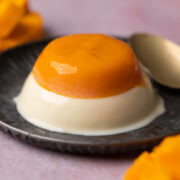
Mango Panna Cotta
Mango Panna Cotta is a gorgeous two-layered dessert that'll wow everybody. It's the perfect cold, summer dessert. This dessert is so versatile because the mango layer can be replaced with berries, kiwis and many other fruits
Servings 6 people
Calories 448kcal
Ingredients
Mango Layer
- 180 Grams Mango Pulp approx 110 grams pulp from one Alphonso mango
- ⅔ Cup Cold Water
- 2 ¼ Teaspoon Gelatin
- 5 Tablespoons Sugar
Vanilla Layer
- ½ Cup Cold Milk
- 2 ½ Teaspoons Gelatin
- ⅔ Cup Sugar
- 2 Cups Cream approx 230 ml in one cup
- 1 Teaspoon Vanilla Extract
Instructions
Mango Layer
- Add cold water to a saucepan. Sprinkle gelatin over it and allow it to bloom, about 5-10 minutes.
- Once the gelatin has bloomed, add sugar and turn on the heat to low. Gently heat the water, allowing the gelatin and sugar to dissolve. Whisk frequently and do not let it simmer. If the saucepan gets too hot, remove from flame until it cools down.
- When the sugar and gelatin has almost dissolved turn off the heat. Add the mango pulp and whisk to combine.
- Divide the mix into the 6 moulds. Refrigerate for 4-6 hours or until firmly set.
Vanilla Layer
- Add cold milk to a saucepan. Sprinkle gelatin over it and allow it to bloom, about 5-10 minutes.
- Once the gelatin has bloomed, add sugar and turn on the heat to low and gently heat the milk allowing the gelatin to dissolve. Whisk frequently and do not let it simmer. If the saucepan gets too hot, remove from flame until it cools down.
- When the sugar and gelatin has almost dissolved turn off the heat. Add the cream and vanilla extract to the saucepan.
- Divide and pour the mix into the mango panna cotta moulds. Refrigerate for 6-8 hours or overnight for best results.
- To demould, run a knife along the side of the jar to loosen the panna cotta. Then immerse the jars or ramekins in warm water for 6-8 seconds, being careful not to let water seep into the panna cotta. Let them rest on the counter for another 5-8 seconds Then carefully invert it onto a plate and demould. Serve immediately.
Video
Notes
- Use the best quality gelatin you can find as low-quality ones may not set properly and sometimes even leave behind a bitter aftertaste.
- Always add gelatin to cold milk or water and turn on the flame only after it has bloomed. This ensures that the gelatin doesn’t burn. We want it to just melt and dissolve
- Add the cream after the sugar has dissolved completely and heat it just enough until everything has blended properly. Make sure that the cream mixture doesn’t boil as that could hamper the setting properties of gelatin.
- Refrigerate both the layers for a minimum of 4 to 6 hours (preferably overnight) to allow them to set properly.
- While full-fat cream works best for this recipe, you can easily substitute it with half and half (half milk half cream) for a lighter version of this recipe.
- If you are a vegetarian and don’t eat gelatin, you can replace it with agar agar or China grass. This ingredient is easily available both online and in local Indian grocery stores.
- To make this recipe vegan, simply substitute milk and cream with a dairy-free option like coconut milk and cream; and the gelatin with agar agar or China grass.
- To demould the panna cotta easily, gently run a knife along the edges of the mould and soak the mould in warm water for a few seconds. Invert and watch the panna cotta slide out.
Nutrition
Calories: 448kcal | Carbohydrates: 42g | Protein: 6g | Fat: 30g | Saturated Fat: 19g | Polyunsaturated Fat: 1g | Monounsaturated Fat: 7g | Cholesterol: 92mg | Sodium: 44mg | Potassium: 108mg | Fiber: 1g | Sugar: 42g | Vitamin A: 1919IU | Vitamin C: 5mg | Calcium: 83mg | Iron: 4mg